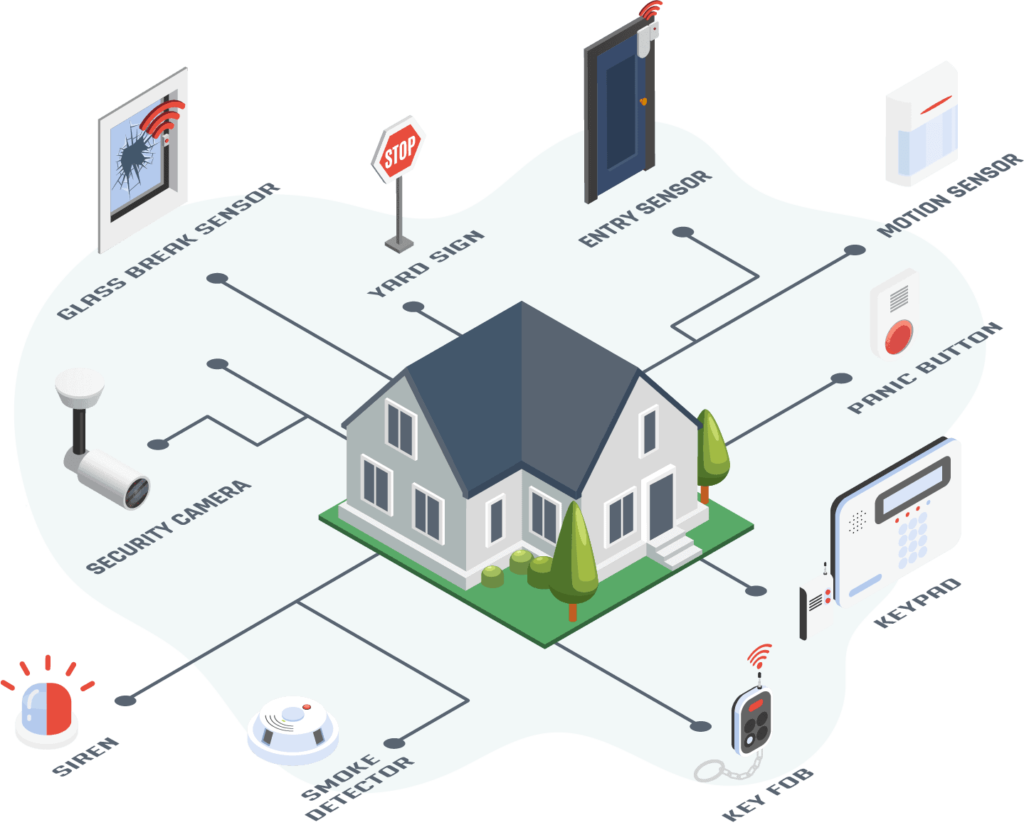What Is A Home Security System?
- Security camera: Smart security cameras hook up to Wi-Fi, enabling us to livestream footage of our system remotely and receive notifications when our cameras detect movement, people, or packages. Many cameras include infrared or color night vision, cloud or local storage, and two-way audio, which allows us to speak to whoever is on camera. Some cameras also have smart platform integrations such as Amazon Alexa or Google Assistant.
- Motion sensor: Motion sensors should be placed in a main entryway or hallway on the ground floor of a home so that they can detect motion and alert us when our system is armed. Some motion sensors are sensitive to pets, so they don’t go off every time our dog walks by.

- Entry sensor: Also known as contact sensors, entry sensors have two parts: one that goes on the window or door and another that goes on the frame. These sensors use magnets to determine when one of these entrances is opened or closed. If the sensor thinks an entry point is opened, it alerts us. We suggest placing entry sensors on windows or doors on the ground floor. The majority are battery-operated, and many even have adhesive backings for easy installation.
- Glass break sensor: Sometimes, instead of opening windows the old-fashioned way, intruders will simply break them open to avoid setting off the entry sensors. However, a glass break sensor also detects the sound of glass breaking and alerts us via mobile notification.
- Siren: Sirens exist in home security systems both on their own and as part of other devices, such as the base station (which we’ll get to below). Sires often go off at the same time as other alarms and are intended to scare intruders away or alert our neighbors.

- Keypad: To arm or disarm, security systems commonly require a code, which we enter on a keypad that’s mounted to the wall or placed on a flat surface.
- Key fob: We have keys to our cars, so why not have them for our security system as well? Key fobs allow us to disarm or arm our security system without having to use a keypad. They’re perfect for when we’re upstairs and just don’t feel like leaving our bed!
- Panic button: If something goes wrong, a panic button is an easy and fast way to alert emergency services, be it the police, hospital, or even the fire department. Like key fobs, panic buttons aren’t installed anywhere in particular, but we always have one around in case of an emergency. We recommend that everyone keep at least one at their bedside table.
- Base station: Base stations sync all of the connected devices with our mobile application so we can receive those notifications we mentioned earlier. Think of it like Grand Central Station, the channel through which trains (i.e., IoT security devices) pass through.
- Yard sign and/ or window stickers: Many security systems also give out yard signs or window stickers that allow us to advertise that we have a security system. Often, burglars will turn around if they see a security system, so these signs are good to have.
- Smoke and CO detectors: We recommend that every home have a smoke and carbon monoxide detector. With this simple tool, we are alerted if the air in our home becomes unsafe to breathe.
Security system components vary wildly from system to system, consisting of just sensors for some companies and all of these components and more for others.
Types of Home Security Systems
There are a few major types of home security systems:
- DIY: With DIY home security systems, the user puts it together themselves and most likely monitors the system themselves through its respective mobile app. However, some DIY systems can have professional monitoring, so the categories aren’t necessarily mutually exclusive.
- Professional: A professional home security system can mean one of two things. One, it can mean professional installation, meaning that a technician installs the equipment. Or two, it can mean a system with professional monitoring, meaning that a team of people responds to alerts from call centers. Again, some professionally monitored systems can also be self-monitored or installed DIY, so these categories aren’t binary.
- Wired: A wired security system is one that is hardwired into a home’s existing electrical system.
- Wireless: A wireless security system, on the other hand, doesn’t have any wires and instead depends on a combination of batteries, Wi-Fi and/or cellular backup to connect to the app and monitoring center, if applicable. Wireless security systems are easier to install than wired systems, but you’ll need to either change or recharge the battery.
- Smart: Smart security systems are connected to the internet, allowing the user to view live footage from a mobile app, receive notifications when alarms go off and control the system remotely.
- Local only: Local alarm systems, in contrast to smart systems, aren’t connected to the internet, so there’s no remote control, monitoring or notifications. Rather, if an alarm goes off, you will only know if you are close enough to hear it. However, local alarm systems can still be professionally monitored via cellular or landline backup.

Professional Monitoring
Many physical systems also come with other services such as 24/7 professional monitoring or cellular, landline, or battery backup, which keep the system on during a power outage.
Alarm systems are rarely connected directly to emergency services dispatch centers. Instead, an alert first goes to the alarm company’s monitoring center, which determines whether emergency services need to be called. Typically, when the monitoring center receives an alert, they place a phone call to the number(s) on file. If that call is answered, the center employee asks for a “safe word” or password to confirm that the person is not under duress. If the call is unanswered or the safe word is not given, the monitoring center will contact the appropriate emergency services dispatch center for fire/police/medical assistance.
Smart home security systems, in particular, connect all components to a mobile application, allowing the user remote control. As smart home ecosystems become more common, they have begun to integrate with voice assistants like Amazon Alexa or Google Assistant, allowing users to command their system using their voice alone. Since we set these systems up to only work for our voices only, burglars can’t disarm our system.
How Do Security Systems Work?
For the majority of home security systems, all of the components connect to a base station. From there, they connect to a mobile application, allowing us to monitor and control everything remotely. The majority of systems use Bluetooth or Wi-Fi or cellular to connect to our phones. Other systems choose to have a landline or battery backup in case of power outages.
When we’re out, we arm our security system. When we return home, we disarm it by inputting our password on a keypad, using a voice command, pressing a key fob, or using our app. When our system is disarmed, none of the sensors go off, and our camera stops automatically recording. In contrast, our smoke and carbon monoxide sensors remain on whether or not our security system is armed. Of course, if our system is armed, the sensors turn on, and our cameras start recording.
We use a mobile application to livestream footage from our security camera, receive notifications from our sensors, speak through two-way audio, and other capabilities. As opposed to a local alarm system, smart home security lets us see what’s going on at home, wherever we are. Local alarms just set off a siren at our house, which isn’t very useful.

How Does Alarm Monitoring Work?
So what happens if someone sets off our armed alarm system? Immediately, our sensors communicate with our base station, which sends a message to our mobile application. Depending on the system, the app, and our phone’s settings, we receive an email notification, a text notification, or a notification within the app. From there, we either livestream footage of what’s happening or use our camera’s two-way audio to speak to whoever is in front of the camera. If we notice that an intrusion is taking place, we call the police.
Of course, we’re busy people and can’t always attend to our security notifications, which is why many companies offer 24/7 professional monitoring with their systems. If one of our alarms goes off, but we cannot deal with it, a professional monitoring team at the monitoring center is notified. After verifying the emergency, they call emergency services for us.

